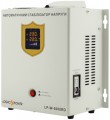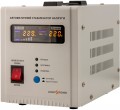Power
The maximum active load power allowed for this model.
Active power is the power that in AC appliances is spent on useful work or on heat generation. In addition to it, such devices also consume reactive power — it goes to the operation of specific components, primarily capacitors and inductors. Apparent power, denoted in volt-amperes (kilovolt-amperes), is the sum of active and reactive, see below about it. Here we note that in simple everyday situations, there is enough data on active power indicated in watts for calculations. In particular, it is this parameter that is considered the key when choosing stabilizers
for washing machines and
dishwashers : in the first case, power from 2 to 5 kW is considered optimal, in the second — from 1.8 to 2.5 kW.
Anyway, the total active power of the connected load should not exceed the figures indicated in the characteristics of the stabilizer. For a full guarantee, it's ok to take a certain margin, but this margin should not be too large — an increase in the allowable power significantly affects the dimensions, weight and price of the device. Also note that there are formulas that allow you to convert the active power consumption into total power, taking into account the type of connected electrical appliance; these formulas can be found in special sources.
Grounded sockets
The number of
sockets for 230 V with grounding provided in the design of the stabilizer.
Some electrical appliances, such as refrigerators and washing/dishwashers, must be grounded when connected. This point should not be ignored — there is a risk of a serious electric shock. Accordingly, the number of sockets with grounding corresponds to the maximum number of such devices that can be simultaneously connected to the stabilizer without the use of splitters. At the same time, ungrounded devices can also be connected to such sockets.
Terminal connection
The presence in the design of the stabilizer of at least two pairs of terminals — at the input and at the output. Unlike sockets, which are designed for frequent connections and disconnections, the
terminal connection is designed to permanently secure the wires — roughly speaking, "attached — clamped — forgot." It does not involve direct connection of electrical appliances, usually the power from the terminals goes further into the mains and is already distributed through it to individual sockets in the room. Accordingly, this option is typical for powerful models (on average from 3 kVA and above, see "Power"), which are designed for installation in one place as a permanent element of the power grid. Often such stabilizers do not have their own outlets at all — only terminals.
Installation
—
Wall mounted. This option includes two installation methods. The first, classic option is hanging with the help of “ears” on screws, studs or other similar devices. Thanks to this, the device does not take up space on the floor, in addition, the owner can choose the installation height; this is especially useful in cramped conditions. The disadvantage of this method, compared with the floor, can be called the need to "hollow the walls" and less suitability for moving from place to place; in addition, it is poorly suited for powerful heavy vehicles. The second type of wall-mounted devices are compact low-power models (usually a voltage relay — see "Device"), plugged into a socket not through a wire, but with a plug on the case itself. In fact, such a device is mounted directly on the outlet and does not require special installation.
— Outdoor. Floor models favorably differ from wall models in simplicity and ease of installation: in fact, apart from a flat surface, nothing else is needed for them. The role of such a surface can be played not only by the floor, but also by a shelf, countertop, etc. (the main thing is that such a design can withstand the weight of the stabilizer), and the installation itself is limited only to moving the stabilizer to the desired point in the room. In addition, the ease of moving from place to place is limited only by the mentioned weight, and it can be almost anything. Thanks to this, among the floor
...models there are options for any available power and "tricks". The main disadvantage of this method is the need for space under the stabilizer on the floor or other surface.
Note that some models allow both wall and floor installation as standard. Such a device can be useful, for example, if you have not yet decided on a specific option, or if the situation can change at any time. In addition, it is technically possible to put the wall model on the floor, and equip the floor model with mounts and hang it on the wall, but usually such tricks at least do not make sense, or even lead to unpleasant consequences (such as overheating or breakage of the mounts).Carrying handle
The presence in the design of the stabilizer of a special
handle for carrying the device from place to place. This feature is useful primarily for powerful and, accordingly, heavy devices, which would be inconvenient to hold directly by the case. And in the most "weighty" models, which are not designed to be carried alone, there are several handles.

